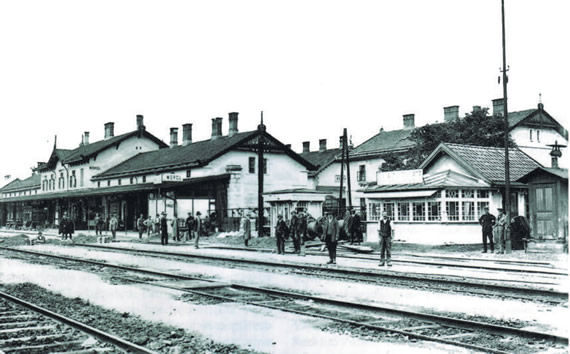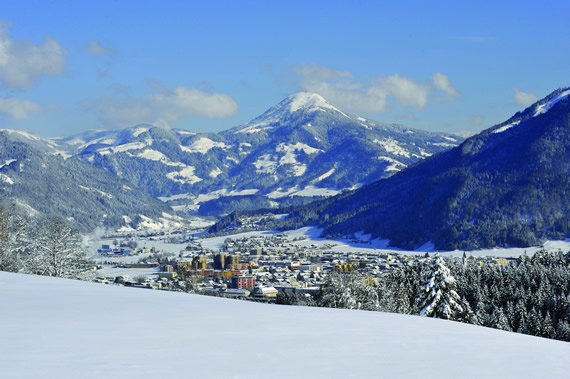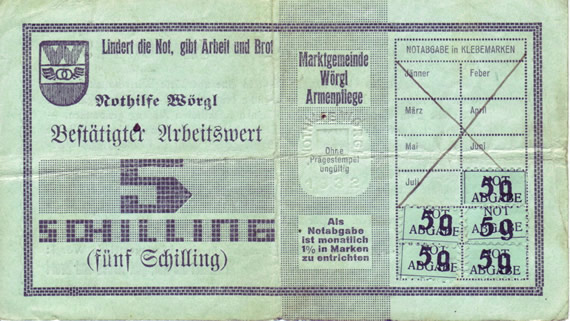Austrian Places: The Woergl Experiment

Our correspondent Markus Reiterer continues his series on those special Austrian places with a story to tell.
It happened as dark times had just grown darker. The young Austrian Republic had emerged from the ashes and the rubble of the once mighty empire – collapsed in the killing fields of the First World War (1914 – 1918) – and it had developed a conviction that – small, truncated and seemingly insignificant as it was – it would never be able to survive.
The emperor had been expelled and nothing seemed the way it was. Thousands and thousands had fallen in the frenzy and the fighting of the war; people had to cope with cold, hunger, disease and – worst of all – hopelessness.
Between 1918 and 1932, 13 governments had come and gone. Stability was nowhere to be seen and political polarization was on the rise. Political parties had begun to arm themselves and Austria started a descent into civil war. And then, there was the economy! Hyperinflation had crippled the economy for years after the war. In 1914, 10,000 crowns had been a fortune that would have bought you a house or two. Eight years later it didn’t even buy a loaf of bread.
It took a comprehensive reform (in 1924), backed by support from the League of Nations, and a tough hard currency policy by the government to start alleviating the problem. Nevertheless any hope for improvement quickly vanished when the world was hit by perhaps the biggest economic crisis in human memory in 1929.
Major banks started to stumble under the pressure of the crisis and unemployment hovered around the 30% margin. No good prospects for the future, no good prospects, indeed. And yet, amidst all this there was a glimmer of hope. A miracle as it was later labeled, but perhaps it was only the relatively short-lived success of a shrewd mayor of an industrial town in the Tyrol, called Woergl.

In 1916, the 32-year-old railroad engineer Michael Unterguggenberger, while doing his military service close to the frontline in what today is known as the Ukraine, came across a strangely named periodical (Der Physiokrat) published in the all but impressive number of 600 and started to read. He found an article published by a man called Silvio Gsell presenting a surprising idea: the problem with money is that it is different from iron.
If you put iron on the shelf, it will start to rust. With money, however, nothing like this would happen. You can put it on the shelf for as long as you want but it will not start to decay. To the contrary, when you put the money in the bank, you will accrue interest -yes, all this is fine for as the companies, managers, farmers, and workers produce enough revenue to finance the interest.
In times of crisis, however, money on the shelf may contribute to a spiraling problem: less available funds, lower wages, less consumption, even more money being stored, fewer sales, bankruptcies, lay-offs, high unemployment.... All this was painfully clear in Austria in the late 1920s and early 1930s.
When Unterguggenberger returned home from the war, he found a job, joined the social democratic party and was elected to the local council of Woergl. He quickly became the leader of the social democrats in the council. The elections of 1928 ended in a tie. Both social democrats and conservatives had the same number of members in the council.
The post of the mayor was decided by lot. Unterguggenberger was not elected. Not yet. Three years later, however, the lot decided again and Unterguggenberger found himself as mayor of the town. By then, the crisis had fully hit Woergl. Companies vanished; workers were laid off, even the local brewery was on the verge of collapse. The unemployment rate had reached 15, 20, 25 per cent and more. There was no improvement in sight.
In order to stabilize the new Austrian currency – the Schilling – the Federal Government reduced the amount of Schillings in circulation, thereby reducing consumption even further. In Woergl as well as other cities, a number of publicly financed projects had to be stopped. When Unterguggenberger decided to introduce his shrewd idea, he also convinced the local council to go ahead. After all: what was there to lose? For years, Unterguggenberger had pondered over the question of how to get money circulating again without borrowing it from the banks and without putting an additional burden on the citizens of his town.
His idea: the town would have to issue its own “money”, to pay for needed construction works and for workers to be able to buy the goods they need. Unterguggenberger did not call the documents he would use “money”, he called them “Arbeitsbestätigungsscheine”- work certificates to which specific values were assigned.
However, that alone would not guarantee that the “certificates” would circulate. So he added an intriguing feature: everyone who wanted to keep a certificate past the end of any given month had to place a stamp on the certificate that could be bought for 1% of the certificate’s value. So in other words: to maintain the value of a 5 Schilling certificate, one would have to place a 5 Groschen stamp on it every month. Suddenly, money had become like iron: it rusted.

Although the people, workers, shopkeepers, farmers, etc. were skeptical at the beginning, the sounds and noises of people working again, seeing the constructions moving ahead, seeing people using this new money and actually buying goods in the store, having drinks in the local pub convinced them. Over time even the innkeepers of neighboring villages began accepting these documents.
The negative interest on the certificates ensured that they were kept in circulation; people started to spend money rather than hoarding it. The community of Woergl received increased tax income – after all people rather wanted to pay tax in advance rather than losing on the certificates by keeping them. This money in turn was used for new initiatives of the community, which again generated new opportunities and new income. Unemployment went down in Woergl while for the rest of Austria it was still on the rise. Politically the rest of Austria became more and more polarized.
In Woergl, however, social democrats and the conservatives jointly (and we may assume generously) celebrated the success of their experiment. Why ponder about ideological differences with such a success at hand? More and more people became interested in the experiment including the national media, and the international press.
Even the U.S. Congress received reports on these seemingly miraculous developments in the Austrian Alps. It is said that up to 200 Austrian communities considered doing the same thing as Unterguggenberger. The end came quickly once the Austrian National Bank heard of these certificates. The bank insisted on its monopoly by law to issue money and took legal steps to shut down the experiment of Woergl – despite the wealth it created, despite the good things it brought to the community of Woergl and its people.
Finally, towards the end of 1933 the Austrian courts had ruled in favor of the National Bank and declared Unterguggenberger’s experiment an infringement of the law. That was it. On September 1, 1933 the circulation of the certificates stopped and so did the generation of wealth. People lost their jobs, consumption decreased, companies agonized and the down-ward spiral continued. Political polarization was on the rise – now also in Woergl.
Six months later Austria fought its civil war. The Woergl experiment still is the subject of considerable debate among experts, which is often more ideological than factual. Some believe that, had the experiment not been stopped, the success would have broadened and a new tool would have been at hand to cope with the crises. Others believe that it was stopped just in time before it could do any harm. Be that as it may, the experiment had brought about a glimmer of hope in difficult times and perhaps that is why so many people still call it a miracle: The miracle of Woergl.
© Markus Reiterer
